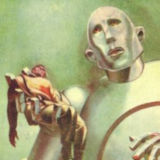
Modern Myth and Meaning is a blog series on the contributions of literature and pop culture to contemporary mythology. It investigates how themes represented in science fiction and fantasy intersect with layers of American consciousness, exploring the meanings of those connections.
You wake up sweating, short of breath. Try to move in the dark but strike a plank on every side. Running your hand across the grain, you recognize wood—pine, from the smell. Inhaling the odor of damp earth, you realize: you’re underground.
For hundreds of years, premature burial has captivated readers and viewers of fiction. Within each story, the act takes on an individuated shade of meaning, but why does it arise again and again? Below are a few themes that emerge across the trope, each reflecting concerns of the time in which a particular story was made or set.
*Contains spoilers*
#1. Human depravity
Burying someone alive doesn’t tend to happen by accident anymore. But since at least the late 1950s, when America was first confronted with sociopaths like Ed Gein and the Manson Family, we’ve had cultural anxiety about the serial killer living next door. Modern thrillers and horror tales help us exhume and grapple with that fear.
- In George Sluizer’s The Vanishing (1988), two characters are buried alive by one killer across a span of years. Although the first victim is lost, Jeff’s rescue offers the viewer a sense of hope.
- In The House of Usher (1960), Roger Corman veers from Poe’s original in that Roderick intentionally buries his sister, Madeline, alive. (No hope on offer here, but viewers may purge some fear of fratricide from their subconscious.)
- In Mary Higgins Clark’s Moonlight Becomes You (1997), Maggie Holloway is buried alive while the plot unfolds via flashback, leaving the reader to piece together the would-be killer’s identity.
In a variation on this theme, such as the 1846 Poe classic “The Cask of Amontillado,” we inhabit the point of view of a killer entombing his victim. This disquieting stance offers a chance to explore taboo questions like, What goes on in the mind of a monster? and Do we have anything in common? On a similar note, Daenerys’s entombing of Doreah and Xaro in Game of Thrones season 2 (2012) is an early sign of where the show would eventually take Daeny’s character arc.
#2. The hero ordeal
When heroes approach mythic status, they need a major ordeal—a challenge that will push them to larger-than-life feats and new heights of our esteem. Crawling out of the grave is not an uncommon way for badass heroes to level up. We see this in Kill Bill, where Beatrix Kiddo punches her way out of a buried coffin. It pops up in Stieg Larsson’s The Girl Who Played with Fire and season six of Buffy the Vampire Slayer, as well.
One interesting twist on this theme involves an intentional premature burial meant as a temporary ordeal. In Ken Seibert’s 1979 story “Night Burial,” a young man asks his friend to inter him as a way of building his inner power. The hero, Terry, is just an ordinary kid with a crazy idea, which puts him in a pretty vulnerable place by the story’s suspenseful conclusion.
The really surprising part? “Night Burial” plays off a real-life fad that grew in popularity in the late sixties, when people vied for the world record for being buried alive. In 1968, two men were buried at the same time, one in England, one in County Cork. Corker Mike Meaney came up last after 61 days, and the Irish threw one hell of a party.
#3. Accidental burial
Without the right equipment, it’s easy to mistake certain disorders such as catalepsy for a deceased state. This was especially true in the nineteenth century, when premature burial due to misdiagnosis was not uncommon. Burying a loved one alive became an all too real concern, leading to cultural traditions such as the Irish wake. Through its master, the American gothic tradition raised the fear of accidentally consigning a loved one to die in the worst way, or of dying that way oneself.
- Poe’s “The Fall of the House of Usher,” published in 1839, features a Roderick who has gone mad and accidentally buried his sister alive. His behavior leaves some room for questions—but if he was easily fooled by her catalepsy, so was his house guest, the story’s narrator. (Accident or no, Madeline was not impressed.)
- Poe’s “Premature Burial” (1844) features a litany of horrible accidents conveyed by a narrator with a winning combination of catalepsy and taphophobia. He says he’s cured now, but should we believe him?
#4. Hope and sacrifice
This version of the trope is perhaps the most amazing: voluntary premature burial as a means of sacrifice, to save or uplift another. Although it can arise in any era, the best examples I’ve found of this theme are from a medieval setting or older. Perhaps acts of martyrdom fit better in a time when the average life expectancy was 30 or lower, bringing the certainty of death nearer than it feels today.
- In Elisha Magus by E.C. Ambrose, published in 2014 but set in the fourteenth century, the protagonist volunteers to be tried for witchcraft to help his friends, earning their trust and redoubling the reader’s sympathy. He hopes to survive being buried alive, but there are a lot of ways his magical plan could go wrong and no one to help if it does. This instance crosses over with the hero ordeal, but the sequence leading up to the burial—in which Elisha is pelted with rotten fruit, ridiculed, and shat on by vengeful crows—evokes the suffering of a martyr.
- According to legend, in 563 St. Oran of Ireland took a pilgrimage to the Isle of Iona in Scotland, where he volunteered to be buried alive in order to keep the chapel walls from falling in. Days later, Oran popped his head up from the grave and let everyone know he’d seen the true afterlife, and guess what? It’s not what we thought! He didn’t get much farther than that before his friend reburied him to shut him up. He may not have had the most discerning taste in friends, but you can’t get much more selfless than St. Oran. He even inspired a poem by Neil Gaiman.
What themes and stories would you add to the list? Let me know in the comments or find me on Twitter. If you enjoyed this post, consider checking out the previous article in in this series.











Recent Comments